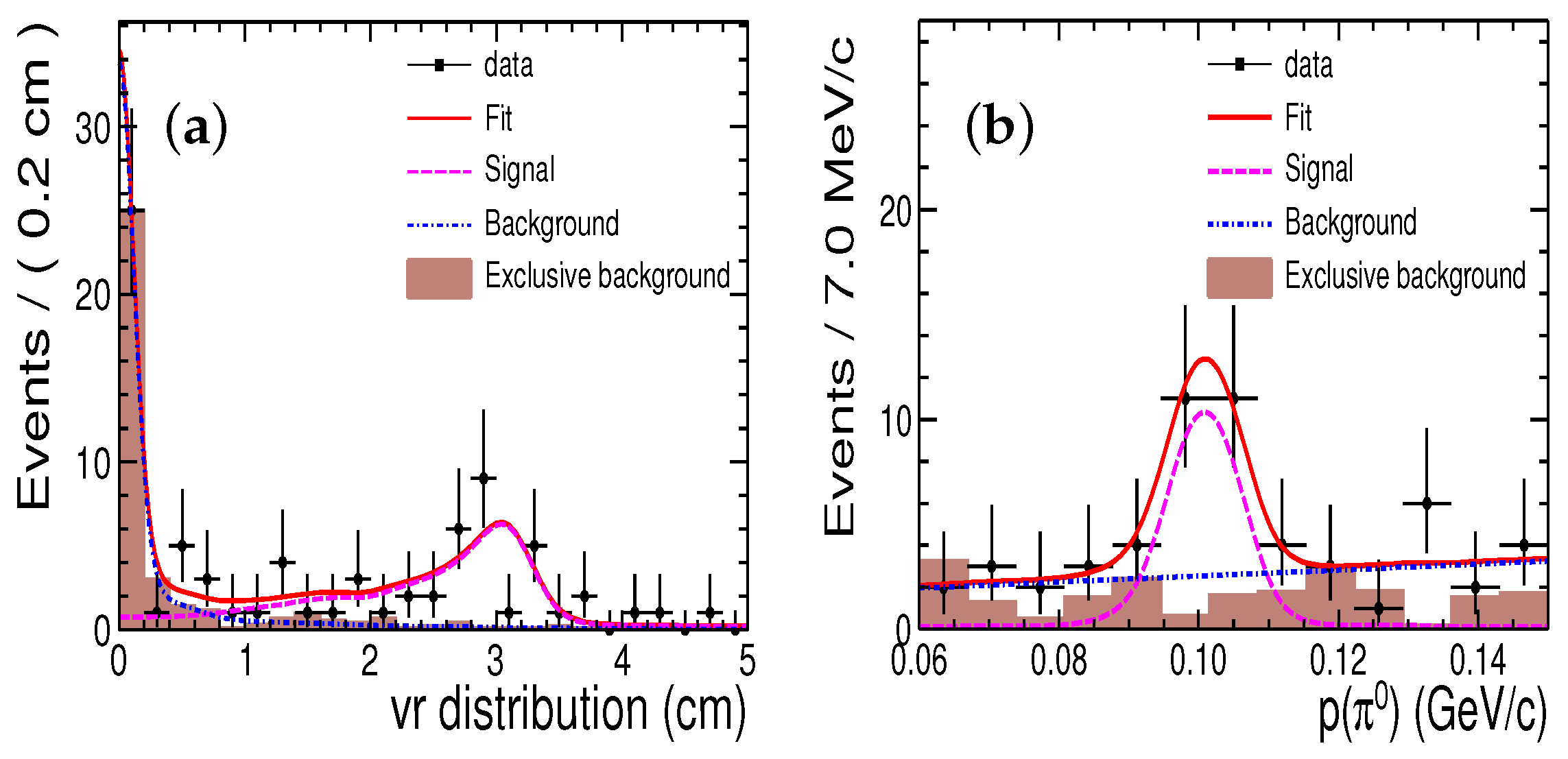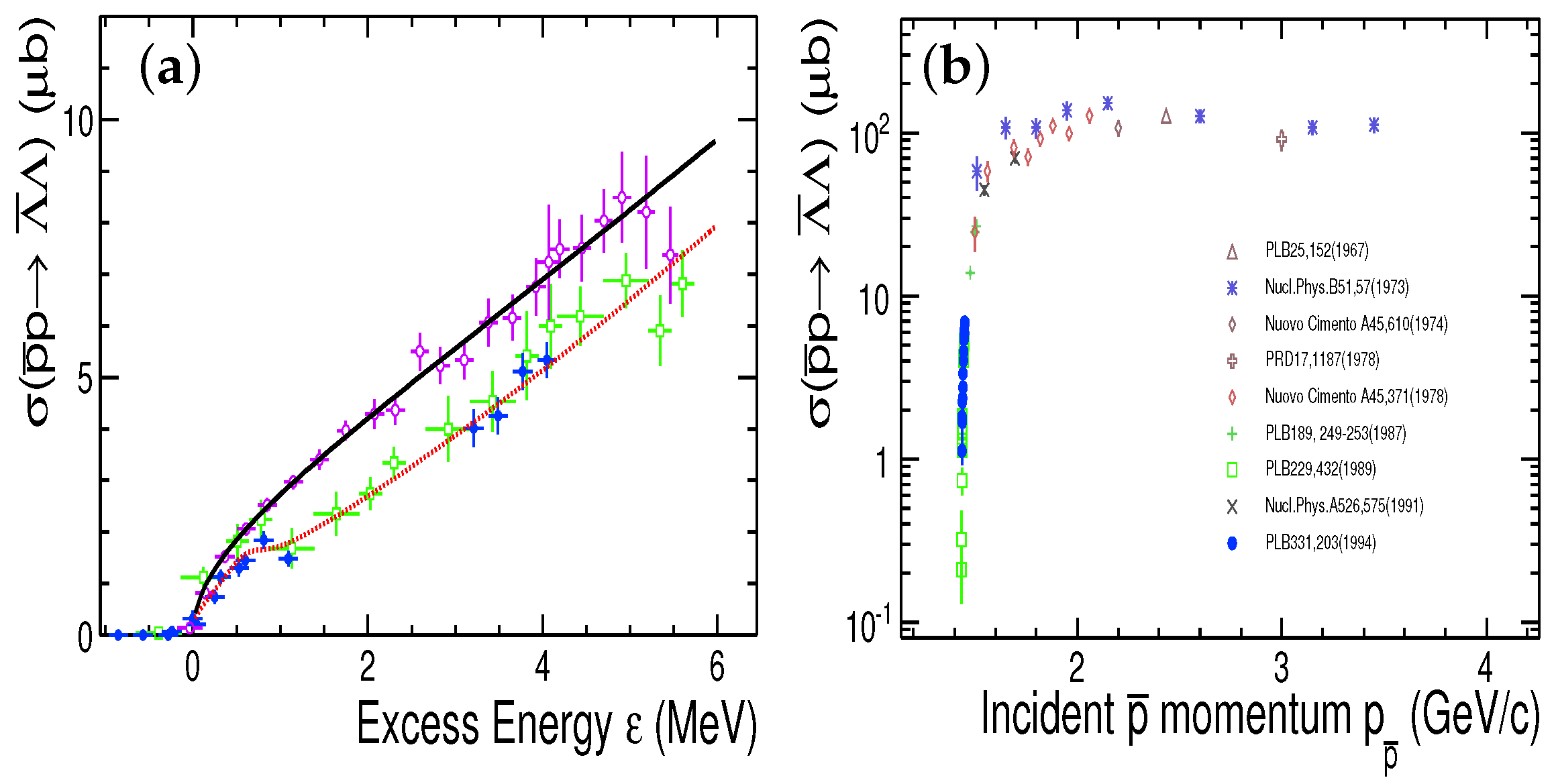Experimental Review of
Abstract
:1. Introduction
2. Experiments and Datasets
2.1. The PS185 at LEAR
2.2. The DM2 at DCI
2.3. The BABAR at PEP-II
2.4. The CLEO-c at CESR
2.5. The BESIII at BEPCII
3. Experimental Results
3.1.
3.2.
4. Theoretical Discussions
5. Conclusions and Prospect
Author Contributions
Funding
Institutional Review Board Statement
Informed Consent Statement
Data Availability Statement
Acknowledgments
Conflicts of Interest
References
- Hopper, V.D.; Biswas, S. Evidence Concerning the Existence of the New Unstable Elementary Neutral Particle. Phys. Rev. 1950, 80, 1099. [Google Scholar] [CrossRef]
- Danysz, M.; Pniewski, J. Delayed disintegration of a heavy nuclear fragment. Philos. Mag. 1953, 44, 350. [Google Scholar] [CrossRef]
- Burkardt, M.; Dillig, M. Reaction in the One Gluon Exchange and the Triplet P Wave Models. Phys. Rev. C 1988, 37, 1362–1364. [Google Scholar] [CrossRef] [PubMed]
- Particle Data Group. The Review of Particle Physics. Prog. Theor. Exp. Phys. 2020, 2020, 1–2093. [Google Scholar]
- Cabibbo, N.; Gatto, R. Electron Positron Colliding Beam Experiments. Phys. Rev. 1961, 124, 1577–1595. [Google Scholar] [CrossRef]
- Schwinger, J. Particle, Sources, and Field; Perseus Books Publishing: New York, NY, USA, 1998; Volume 3. [Google Scholar]
- Arbuzov, A.B.; Kopylova, T.V. On relativization of the Sommerfeld-Gamow-Sakharov factor. J. High Energy Phys. 2012, 1204, 9. [Google Scholar] [CrossRef] [Green Version]
- Barnes, P.D.; Besold, R.; Birien, P.; Bonner, B.E.; Breunlich, W.H.; Diebold, G.; Dutty, W.; Eisenstein, R.A.; Ericsson, G.; Eyrich, W.; et al. Threshold Measurement of the Reaction at LEAR. Phys. Lett. B 1989, 229, 432–438. [Google Scholar] [CrossRef] [Green Version]
- Barnes, P.D.; Birien, P.; Breunlich, W.H.; Dutty, W.; Eisentein, R.A.; Ericsson, G.; Eyrich, W.; Fischer, H.; Frankenberg, R.V.; Franklin, G.; et al. Study of the reaction below 6-MeV excess energy. Phys. Lett. B 1994, 331, 203–210. [Google Scholar] [CrossRef]
- Barnes, P.D.; Franklin, G.; McCrady, R.; Merrill, F.; Meyer, C.; Quinn, B.; Schumacher, R.A.; Zeps, V.; Hamann, N.; Eyrich, W.; et al. High statistics measurements of the and + c. c reactions at threshold. Phys. Rev. C 2000, 62, 055203. [Google Scholar]
- Bisello, D.; Busetto, G.; Castro, A.; Nigro, M.; Pescara, L.; Posocco, M.; Sartori, P.; Stanco, L.; Antonelli, A.; Biagini, M.E.; et al. DM2 Collaboration. Baryon pair production in e+e− annihilation at = 2.4 GeV. Z. Phys. C 1990, 48, 23–28. [Google Scholar]
- Dobbs, S.; Seth, K.K.; Tomaradze, A.; Xiao, T.; Bonvicini, G. Hyperon Form Factors & Diquark Correlations. Phys. Rev. D 2017, 96, 092004. [Google Scholar]
- Ablikim, M.; Achasov, M.N.; Ahmed, S.; Ai, X.C.; Albayrak, O.; Albrecht, M.; Ambrose, D.J.; Amoroso, A.; An, F.F.; An, Q.; et al. Observation of a cross-section enhancement near mass threshold in e+e−→. Phys. Rev. D 2018, 97, 032013. [Google Scholar] [CrossRef] [Green Version]
- Ablikim, M.; Achasov, M.N.; Adlarson, P.; Ahmed, S.; Albrecht, M.; Aliberti, R.; Amoroso, A.; An, M.R.; An, Q.; Bai, X.H.; et al. Measurement of the Cross Section for e+e−→ and Observation of the Decay ψ(3770)→. Phys. Rev. D 2021, 104, L091104. [Google Scholar] [CrossRef]
- Aubert, B.; Bona, M.; Boutigny, D.; Karyotakis, Y.; Lees, J.P.; Poireau, V.; Prudent, X.; Tisser, V.; Zghiche, A.; Tico, J.; et al. BaBar Collaboration. Study of e+e−→, 0, Σ00 using initial state radiation with BABAR. Phys. Rev. D 2007, 76, 092006. [Google Scholar] [CrossRef] [Green Version]
- Budker, G.I.; Skrinsky, A.N. The electron Cooling and New Possibilities in Elementary Particle Physics. Sov. Phys. Uspekhi 1978, 21, 277–298. [Google Scholar] [CrossRef]
- Augustin, J.E.; Bussetto, G.; Capon, G.; Cosme, G.; Dudelzak, B.; Eschstruth, P.; Fulda, F.; Grelaud, B.; Grosdidier, G.; Jean-Marie, B.; et al. Dm2: A Magnetic Detector for the Orsay Storage Ring DCI. Phys. Scr. 1981, 23, 623–633. [Google Scholar] [CrossRef]
- Aubert, B.; Bazan, A.; Boucham, A.; Boutigny, D.; De Bonis, I.; Favier, J.; Gaillard, J.-M.; Jeremie, A.; Karyotakis, Y.; Le Flour, T.; et al. BaBar Collaboration. The BaBar detector. Nucl. Instrum. Meth. A 2002, 479, 1–116. [Google Scholar] [CrossRef] [Green Version]
- Dobbs, S.; Metreveli, Z.; Seth, K.K.; Tomaradze, A.; Ecklund, K.M.; Love, W.; Savinov, V.; Lopez, A.; Mehrabyan, S.; Mendez, H.; et al. CLEO Collaboration. Measurement of absolute hadronic branching fractions of D mesons and e+e−→ cross-sections at the ψ(3770). Phys. Rev. D 2007, 76, 112001. [Google Scholar] [CrossRef] [Green Version]
- Ablikim, M.; An, Z.H.; Bai, J.Z.; Berger, N.; Bian, J.M.; Cai, X.; Cao, G.F.; Cao, X.X.; Chang, J.F.; Chen, C.; et al. Design and Construction of the BESIII Detector. Nucl. Instrum. Meth. A 2010, 614, 345–399. [Google Scholar] [CrossRef] [Green Version]
- Ablikim, M.; Achasov, M.N.; Saher, A.; Albrecht, M.; Antonio, A.; An, F.F.; An, Q.; Bai, J.Z.; Bai, Y.; Bakina, O.; et al. Study of J/ψ and ψ(3686) decay to and Σ00 final states. Phys. Rev. D 2017, 95, 052003. [Google Scholar] [CrossRef] [Green Version]
- Besiii Collaboration. Polarization and Entanglement in Baryon-Antibaryon Pair Production in Electron-Positron Annihilation. Nat. Phys. 2019, 15, 631–634. [Google Scholar] [CrossRef] [Green Version]
- Ablikim, M.; Achasov, M.N.; Adlarson, P.; Ahmed, S.; Albrecht, M.; Alekseev, M.; Amoroso, A.; An, F.F.; An, Q.; Bai, Y.; et al. Complete Measurement of the Λ Electromagnetic Form Factors. Phys. Rev. Lett. 2019, 123, 122003. [Google Scholar] [CrossRef] [PubMed] [Green Version]
- Ablikim, M.; Achasov, M.N.; Adlarson, P.; Ahmed, S.; Albrecht, M.; Aliberti, R.; Amoroso, A.; An, M.R.; An, Q.; Bai, X.H.; et al. Measurement of Λ baryon polarization in e+e−→ at = 3.773 GeV. arXiv 2021, arXiv:2111.11742. [Google Scholar] [CrossRef]
- Huang, G.; Ferroli, R.B. Probing the internal structure of baryons. Natl. Sci. Rev. 2021, 8, nwab187. [Google Scholar] [CrossRef]
- Pacetti, S.; Ferroli, R.B.; Tomasi-Gustafsson, E. Proton electromagnetic form factors: Basic notions, present achievements and future perspectives. Phys. Rept. 2015, 550–551, 1–103. [Google Scholar] [CrossRef]
- Carbonell, J.; Protasov, K.V.; Dalkarov, O.D. On a possible near threshold Lambda Anti-lambda state. Phys. Lett. B 1993, 306, 407–410. [Google Scholar] [CrossRef]
- Bugg, D.V. Partial wave analysis of . Eur. Phys. J. C 2004, 36, 161–168. [Google Scholar] [CrossRef]
- Klempt, E.; Bradamante, F.; Martin, A.; Richard, J.M. Antinucleon nucleon interaction at low energy: Scattering and protonium. Phys. Rep. 2002, 368, 119–316. [Google Scholar] [CrossRef]
- Haidenbauer, J.; Meißner, U.G. The electromagnetic form factors of the Λ in the timelike region. Phys. Lett. B 2016, 761, 456–461. [Google Scholar] [CrossRef] [Green Version]
- Cao, X.; Dai, J.P.; Xie, Y.P. Vector mesons and electromagnetic form factor of the Λ hyperon. Phys. Rev. D 2018, 98, 094006. [Google Scholar] [CrossRef] [Green Version]
- Xiao, L.Y.; Weng, X.Z.; Zhong, X.H.; Zhu, S.L. A possible explanation of the threshold enhancement in the process e+e−→. Chin. Phys. C 2019, 43, 113105. [Google Scholar] [CrossRef]
- Li, Z.Y.; Dai, A.X.; Xie, J.J. Electromagnetic form factors of Λ hyperon in the vector meson dominance model and the near-threshold enhancement of the e+e−→ reaction. arXiv 2019, arXiv:2107.10499. [Google Scholar]
- Baldini, R.; Pacetti, S.; Zallo, A.; Zichichi, A. Unexpected features of e+e−→ and e+e−→ cross sections near threshold. Eur. Phys. J. A 2009, 39, 315–321. [Google Scholar] [CrossRef] [Green Version]
- Brodsky, S.J.; Hoang, A.H.; Kuhn, J.H.; Teubner, T. Angular distributions of massive quarks and leptons close to threshold. Phys. Lett. B 1995, 359, 355–361. [Google Scholar] [CrossRef] [Green Version]
- Haidenbauer, J.; Holinde, K.; Mull, V.; Speth, J. Meson exchange and quark - gluon transitions in the anti-p p → anti-Lambda Lambda process. Phys. Rev. C 1992, 46, 2158–2171. [Google Scholar] [CrossRef]
- Lutz, M.F.M. Physics Performance Report for PANDA: Strong Interaction Studies with Antiprotons. arXiv 2009, arXiv:0903.3905. [Google Scholar]
- Kou, E. The Belle II Physics Book. PTEP 2019, 2019, 123C01. [Google Scholar] [CrossRef]
- Ablikim, M.; Achasov, M.N.; Adlarson, P.; Ahmed, S.; Albrecht, M.; Alekseev, M.; Amoroso, A.; An, F.F.; An, Q.; Bai, Y.; et al. Future Physics Programme of BESIII. Chin. Phys. C 2020, 44, 040001. [Google Scholar] [CrossRef]



Publisher’s Note: MDPI stays neutral with regard to jurisdictional claims in published maps and institutional affiliations. |
© 2022 by the authors. Licensee MDPI, Basel, Switzerland. This article is an open access article distributed under the terms and conditions of the Creative Commons Attribution (CC BY) license (https://creativecommons.org/licenses/by/4.0/).
Share and Cite
Zhou, X.; Yan, L.; Ferroli, R.B.; Huang, G.
Experimental Review of
Zhou X, Yan L, Ferroli RB, Huang G.
Experimental Review of
Zhou, Xiaorong, Liang Yan, Rinaldo Baldini Ferroli, and Guangshun Huang.
2022. "Experimental Review of





